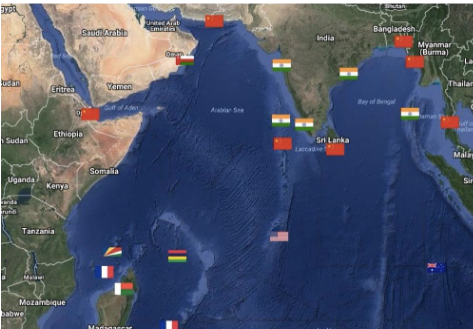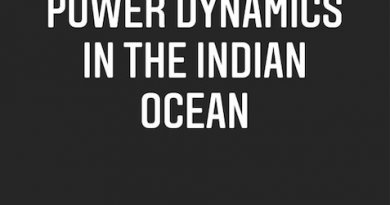Amid geopolitical shifts, who will rule the Indian Ocean
A here is space for India to advance its geo-strategic interests. But with the US increasingly looking inwards, will India join other countries in ‘cooperating’ with Chinese initiatives, or will it offer an alternative project?Even as the India-China land border tensions mount, the Indian Ocean, too, is heating up. The geopolitical narratives emanating from the Covid-19 outbreak have led to a severe blame game between the US and China. The impact of this is felt in the Indian Ocean too. The region is already a defining constituent of the Free and Open Indo-Pacific (FOIP) strategy being pursued by the US —though not with a position of strength anymore. China, on the other hand, rejects the FOIP strategy, which it sees as an effort to contain its rise, even as it maintains its own strategic interests in the region.The Indian Ocean, therefore, caters to both these competing views and exhibits a unique geopolitical gravity. It’s an economy, a cultural landscape and a strategic hotspot. In fact, this is the region where India asserts, China eyes, and the US intervenes. But who dominates? That solicits a deeper response.
IOR infra developmentThe Indian Ocean Rim’s (IOR’s) infrastructure and connectivity is a critical investment opportunity. Undoubtedly, China leads the show. It is the main initiator and promoter of infrastructural development in the region. But how sustainable is the Chinese model? That is to be determined by its ability to collaborate with other member countries of the IOR. From the ports of Mombasa in Kenya to Chittagong in Bangladesh, Chinese investments have engulfed the region. Sri Lanka had once desired to revoke Chinese presence on its much hyped Hambantot a port.A question, however, remains. Is the Chinese flagship project —the Belt and Road Initiative (BRI) —overlapping with the IOR’s strategic frame? Perhaps yes. The Gwadar port in Pakistan’s Balochistan province is a sensitive geo-strategic outpost. It is pivotal for at least two segments of the BRI, viz the Maritime Silk Road and the China-Pakistan Economic Corridor (CPEC). It is also among the most controversial ports from India’s perspective. India sees the CPEC, which traverses through Pakistan-occupied Kashmir, as violating its sovereignty. Also, India keeps a soft corner for Balochistan, which is engaged in a freedom movement to separate from Pakistan. Baloch leaders have even sought India’s permission to establish their government-in-exile in New Delhi.India has, however, invested heavily in developing the Chabahar port, which lies in the Sistan and Baluchestan province of Iran. It is situated merely 70 km away from Gwadar. Former Prime Minister Manmohan Singh saw it as a clear alternative that served India’s national interest while by-passing Pakistan. However, American sanctions on Iran have often interrupted India’s engagements in Chabahar. They have also adversely affected the prospects of the Iran-Pakistan-India (IPI) gas pipeline for an energy-dependant India.
Strategic partnerships
Connectivity issues in the IOR are not confined only to American, Indian or Chinese stances. They also depend on how the strategic interests of other stakeholders, including Japan and Russia, evolve. Japan, along with the US and Australia, is India’s partner in the Quadrilateral Security Dialogue (or the Quad). The Quad is a strategic alliance viewed to be positioned against China’s rise in the Indo-Pacific region.
Russia, on the other hand, seems to be getting an even closer access to the IOR countries via the evolving BRI infrastructure in Central Asia.The western and eastern sides of the Indian Ocean are geo-strategically distinct. The western side comprises some strategic islands. Diego Garcia and Seychelles host the American military base, while China may soon establish one of its own in the Maldives. The eastern side largely hosts strategic ports controlled by China. However, for China, the distinction seems bleak, as its ‘string of pearls’ includes ports from South-East Asia to the East Coast of Africa and beyond.In the Indo-Pacific, and particularly the IOR, the US has become an increasingly unpredictable strategic partner. It has failed to deliver an alternative infrastructure roadmap. For instance, the New Silk Road project launched by the US in 2011 —though originally proposed in the 1990s as a potential follow-up to military withdrawal from Afghanistan —has not delivered any meaningful civilian economic benefit. Even America’s withdrawal from the Trans-Pacific Partnership (TPP) was heavily criticised by the Indo-Pacific nations for its potentially predatory and non-reciprocal prescriptions.The TPP narrative also illustrates that the US had embarked in an ever more aggressive anti-China regional containment policy. This has diminished the much-needed policy space for peaceful conflict resolution, including in the South China Sea. The FOIP strategy of the US also did not yield any concrete geo-economic and geo-strategic assurances. Thus, the Indian Ocean riparian countries were compelled to shape their foreign policy vis-à-vis Chinese aid and BRI investments —both of which were in centivising. These countries are cooperative, not confrontational, with China. They seek convergences, not divergences, with the Chinese investment roadmap.
Opportunity for IndiaUltimately, one last question remains. Who may be the net security provider in the IOR? By any geographic, demographic, or historical standards, it should be India. No one else can help sustain a stable strategic environment in this region. This entails a political commitment that necessitates heavy investments in naval infrastructure. Though India takes the lead in naval surveillance and counter-piracy measures, its naval modernisation programme still needs a boost.India ought to strive and formally reposition itself as a net security provider in the IOR. Adopting a differentiated foreign policy postured to engage all stakeholders —viz, the US, China, Russia and Japan —but not prioritise any of them, will help. India need only invest into its military-strategic assets in the IOR to the extent that it grows economically.
However, neither Japan nor the US can offer India an economic prowess comparable to what ‘strategic coopetition’ with China can do. If India is hesitant to collaborate with China on infrastructural development, it must offer an alternative project for the benefit of IOR riparian countries. This may be done jointly with Japan, but will require a robust roadmap and huge financial commitments. On the other hand, the US has not proven its ability to hold its security guarantees for the riparian states. It is actually in a process of retreating from global engagements toward an inward-looking, protectionist stance.
India’s strategic vision for the IOR is based on the initiative named Security and Growth for All in the Region (SAGAR). SAGAR has the potential to provide solutions to India’s maritime security challenges. It can forge a consultative mechanism aimed at strengthening India’s geo-strategic outreach. But doing so solicits a strategic depth, not social media representations!
Source; thehindubusinessline.com




